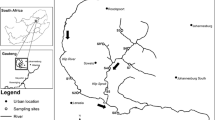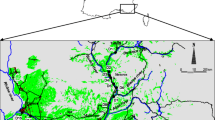Abstract
Seventeen parent polycyclic aromatic hydrocarbons (PAHs) and 38 congeners of polychlorinated biphenyls were measured at five different sediment depths (between the surface and ~300 cm below the seafloor) at 160 sites in Naples harbour. Total PAH (ΣPAH) and PCB (ΣPCB) concentrations ranged between 0.012–21.73 − nd 0.001–0.222 mg kg − 1, respectively. For PAHs, an evident and progressive decrease in concentration with depth documents the effects of a more intense anthropic impact of this group of pollutants in the recent period. A selected number of PAH isomer pairs (phenanthrene/anthracene, fluoranthene/pyrene and benzo(a)anthracene/crysene) were used to distinguish between contaminants of pyrolitic and petrogenic origin. More than 90% of PAHs present at the different depths of the studied sediments indicate pyrolitic industrial origins. On the other hand, relatively high concentrations of three- and four-ring PAHs suggest a limited contribution of vehicular emissions to the contamination of sediments. An unexpected and systematic increase of ΣPCB concentration, exceeding values approved by international regulations, was found in the studied sediments, testifying to the uncontrolled discharge to the studied area from industrial and commercial activity on nearby land. Ecotoxicological risk levels calculated for PAHs suggests a relatively elevated level of toxicity in surface sediments decreasing with depth and very low toxicity values associated to PCB toxicity.
Similar content being viewed by others
References
Ahlborg, U., Becking, G. C., Birbaum, L. S., Brouwer, A., Derks, J. G. M., Feely, M., et al. (1994). Toxic equivalency factors for dioxin-like PCBs. Chemosphere, 28, 1049–1067.
Boehm, P. D., Douglas, G. S., Burns, W. A., Mankiewicz, P. J., Page, D. S., & Bence, A. E. (1998a). Application of petroleum hydrocarbon chemical fingerprinting and allocation technique after the Exxon Valdez oil spill. Marine Pollution Bulletin, 34, 559–613.
Boehm, P. D., Page, D. S., Gilfillan, E. S., Bence, E. A., Burns, W. A., & Mankiewicz, P. J. (1998b). Study of the fates and effects of the Exxon Valdez oil spill on benthic sediments in two bays in prince William Sound, Alaska. Study design, chemistry, and source fingerprinting. Environmental Science and Technology, 32, 599–613.
Burns, W. A., Mankiewicz, P. J., Bence, A. E., Page, D. S., & Parker, K. (1997). A least squares method for allocating sediment hydrocarbons to multiple sources. Environmental Toxicology and Chemistry, 16, 1119–1131.
Budziski, H., Jones, I., Bellocq, J., Pierard, C., & Garrigues, P. (1997). Evaluation of sediment contamination by polycyclic aromatic hydrocarbons in the Gironde estuary. Marine Chemistry, 58, 85–97.
Chandra, S., Ward, C. H., & Hughes, D. J. (1996). Biodegradation of sorbed fluorine in sediment slurries. Hazardous Waste and Hazardous Material, 13, 375–385.
COUNCIL DIRECTIVE 85/467/EEC of 1 October 1985 amending of sixth time Directive 76/769/EEC on the approximation of the laws, regulations and administrative provisions of the Members States relating to restrictions on the marketing and use of certain dangerous substances and preparation (PCBs/PCTs).
Frignani, M., Bellucci, L. G., Carraro, C., & Favotto, M. (2004). Accumulation of polychlorinated biphenyls in sediments of the Venice Lagoon and the industrial area of Porto Marghera. Chemosphere, 54, 1563–1572.
Gogou, A., Stratigakis, N., Kanakidou, M., & Stephanou, E. G. (1996). Organic aerosols in Eastern Mediterranean: Components source reconciliation by using molecular markers and atmospheric back trajectories. Organic Geochemistry, 25, 79–96.
Gschwend, P. M., & Hites, R. A. (1981). Fluxes of polycyclic aromatic hydrocarbons to marine and lacustrine sediments in the north eastern United States. Geochemica et Cosmochimica Acta, 45, 2359–2367.
Keith, L., & Telliard, W. A. (1979). Priority pollutants 1—a perspective view. Environmental Science and Technology, 13, 416–423.
Nagao, T., Golor, G., Hagenmaier, H., & Neubert, D. (1993). Teratogenic potency of 2,3,4,7,8-pentachlorodibenzofuran and of three mixtures of polychlorinated dibenzo-p-dioxins and dibenzofurans in mice. Problems with risk assessment using TCDD toxic-equivalency factors. Toxicology, 57, 591–597.
NATO/CCMS (1988). Scientific basis for the development of international toxicity equivalency factor (I-TEF), method of risk assessment for risk assessment for complex mixtures of dioxins and related compounds. Washington: North Atlantic Treaty Organization/Committee on the Challenges of Modern Society (p. 178).
Page, D. S., Boehm, P. D., Douglas, G. S., Bence, E. A., Burns, W. A., & Mankiewicz, P. J. (1999). Pyrogenic polycyclic aromatic hydrocarbons in sediments record past human activity: a case study in Prince William Sound, Alaska. Marine Pollution Bulletin, 38, 247–260.
Peters, C. A., Knightes, C. D., & Brown, D. G. (1999). Long-term composition dynamics of PAH-containing NAPLs and implications for risk assessment. Environmental Science and Technology, 33, 4499–4507.
Readman, J. W., Fillmann, G., Tolosa, I., Bartocci, J., Villeneuve, J. P., Catinni, C., et al. (2002). Petroleum and PAH contamination of the Black Sea. Marine Pollution Bulletin, 40, 48–62.
Rice, D. C., & Hayward, S. H. (1997). Effects of postnatal exposure to a PCBs mixture in monkeys on nonspatial discrimination reversal and delayed alternation performance. Neurotoxicology, 18(2), 479–494.
Schantz, S. L. (1996). Developmental neurotoxicity of PCBs in humans: What do we know and where do we go from here? Neurotoxicology and Teratology, 18(3), 217–227.
Soclo, H. H., Garrigues, P., & Ewald, M. (2000). Origin of polycyclic aromatic hydrocarbons (PAHs) in coastal marine sediments: case studies in Cotonou (Benin) and Aquitanie (France) areas. Marine Pollution Bulletin, 5(4), 387–396.
Sprovieri, M., Feo, M. L., Prevedello, L., Malvagio Manta, D., Sammartino, S., Tamburino, S., et al. (2007). Heavy metals, polycyclic aromatic hydrocarbons and polychlorinated biphenyls in surface sediments of the Naples harbour (southern Italy). Chemosphere, 67, 998–1009.
US EPA (1984). Health effects assessment of polycyclic aromatic hydrocarbons (PAHs). EPA 540/1-86-013. Cincinnati: U.S. Environmental Protection Agency Environmental Criteria and Assessment Office.
Van der Berg, M., Birgnbaum, L., Bosveld, A. T. C., Brunstrom, B., Cook, P., Feeley, M., et al. (1998). Toxic equivalency factors (TEFs) for PCBs, PCDDs, PCDFs for humans and wildlife. Environmental Health Perspective, 106, 775–792.
Wang, Z., Fingas, M., & Page, D. S. (1999a). Oil spill identification. Journal of Chromatography A, 843, 369–411.
Wang, Z., Fingas, M., Shu, Y. Y., Sigouin, L., Landriault, M., Lambert, P., et al. (1999b). Quantitative characterization of PAHs in burn residue and soot samples and differentiation of pyrogenic PAHs from petrogenic PAHs—the 1994 mobile burn study. Environmental Science and Technology, 33, 3100–3109.
Wentworth, C. K. (1922). A scale of grade and class terms for clastic sediments. Journal of Geology V, 30, 377–392.
William, P. T., Bartle, K. D., & Andrew, G. E. (1986). The relation between polycyclic aromatic compounds in diesel fuels and exhaust particulates. Fuel, 65, 1150–1158.
Xue, W., & Warshawsky, D. (2005). Metabolic activation of polycyclic and heterocyclic aromatic hydrocarbons and DNA damage: A review. Toxic and Applied Pharmacy, 206, 73–93.
Yunker, M. B., & Macdonald, R. W. (1995). Alkane and PAH depositional history, sources and fluxes in sediments from the Fraser River Basin and Strait of Georgia, Canada. Organic Geochemistry, 34, 1429–1454.
Yunker, M. B., Snowdon, L. R., Macdonald, R. W., Smith, J. N., Fowler, M. G., Skibo, D. N., et al. (1996). Polycyclic aromatic hydrocarbon composition and potential sources for sediment samples from Beaufort and Barents Seas. Environmental Science and Technology, 30, 1310–1320.
Yunker, M. B., Macdonald, R. W., Goyette, D., Paton, D. W., Fowler, B. R., Sullivan, D., et al. (1999). Natural and anthropogenic inputs of hydrocarbons to the Strait of Georgia. Science of the Total Environment, 225, 181–209.
Yunker, M. B., Macdonald, R. W., Vingarzan, R., Mitchell, R. H., Goyette, D., & Sylvestre, S. (2002). PAHs in the Fraser River basin: a critical appraisal of PAH ratios as indicators of PAH sources and composition. Organic Geochemistry, 33, 489–515.
Author information
Authors and Affiliations
Corresponding author
Rights and permissions
About this article
Cite this article
Feo, M.L., Sprovieri, M., Gherardi, S. et al. Polycyclic aromatic hydrocarbons and polychlorinated biphenyls in the harbour of Naples (Southern Italy): time and spatial distribution patterns. Environ Monit Assess 174, 445–459 (2011). https://doi.org/10.1007/s10661-010-1469-5
Received:
Accepted:
Published:
Issue Date:
DOI: https://doi.org/10.1007/s10661-010-1469-5




